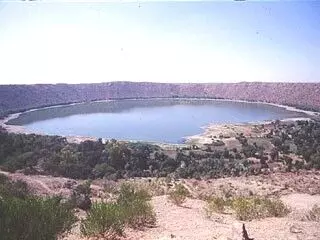Lonar: All you want to know about a lake formed by meteorite
The distance by road from Hyderabad to Lonar in Maharashtra is 450 km, it is the second-largest meteorite impact crater in the world
By Beyniaz Edulji
Lonar: A lake formed by meteorite
Hyderabad: The Lonar Crater is in Maharashtra. It is the second-largest meteorite impact crater in the world. This circular depression is filled by a saltwater lake, which is the third-largest lake in the world. This site was discovered by a British officer, CJE Alexander, in 1823. The Lonar Crater is a depression 7 km in circumference, 1.83 km in diameter, and 150 meters deep, formed in the basalt rock of the Deccan Plateau 52,000 years ago by a meteorite. The Crater and Lake are named after the Goddess Lonar Devi.
Road trip to Lonar
The distance by road from Hyderabad to Lonar is 450 km. Check the road conditions if you are driving there before you set out, as the roads off the highways may be subject to monsoon wear and tear. When we reached there after 9 hours of driving, we saw some other tourists as well as pilgrims and scientists from all over the world, although not in the numbers that this beautiful site deserves. The best season to visit this place is in winter. The forest around the lake is bright green and very beautiful during the monsoons, but the trek down to the lake can be very slippery and treacherous during the rains.
The Maharashtra Tourism Development Corporation has a Crater View Tourist Complex nearby. There is also a PWD/Forest rest house. The nearest railway station to Lonar is Jalna, 90 km away. It is located 160km away from Aurangabad airport, and tourists visiting the city of Aurangabad are taken by taxi or bus to Lonar. It is a 3-hour drive from Aurangabad.
Unique micro eco-system
The saline Lonar Lake is 1.2 km in diameter and 137 meters deep. In the days of EmperorAkbar, a salt factory was located here. The crater has a unique self-evolved micro ecosystem, leading to the evolution of new life forms.
Rich in Minerals
The lake is rich in minerals and is said to heal many skin diseases. Some visitors come just to bathe in the lake’s waters. The sides of the lake are slippery and uneven, and guides warn of snakes present here. It is a long and tiring trek and should not be attempted in summer when temperatures rise dangerously high.
Little Lonar crater and Amber Lake
Many prefer to visit the mini crater called Little Lonar Crater, which was formed when a small piece of the meteorite split and hit the ground a little distance away from the main crater. This depression is 340 meters in diameter and easier to trek. The AmberLake was formed in this depression.
Several Temples
There are 14 ancient temples in Lonar, the oldest being 1,300 years old. All the temples are constructed without using any cement. The Gomukh temple is located along the rim of the Lonar Crater. It is famous for its perennial stream where pilgrims come to bathe.
The beautiful Daityasudan temple was built in honour of Lord Vishnu’s victory over the giant Lonasur. It has intricate carvings.
Forests
The area around the Lonar Crater is covered by thick forests, which are full of colorful birds. One can see flamingos in Lonar Lake in winter. The Lonar crater is the home of hundreds of peacocks that call out to each other in their strangely harsh voices. This area has a wide range of plant and animal life. One can see monitor lizards, deer, foxes, and langur
monkeys, green bee-eaters, rabbits, and birds like cranes, robins, pipits, ducks, teals, herons, blue jays, swallows, tailorbirds, and robins.